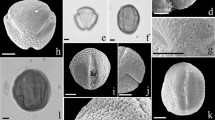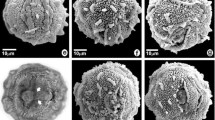Abstract
The utility of pollen characteristics for taxonomic and phylogenetic analysis of most genera of Podostemaceae has barely been examined. Herein we report on the diversity of pollen structure in Castelnavia (Podostemaceae), a genus of six species endemic to central and southern Brazil. Pollen grain was shed as three-colpate, planaperturate monads and ranged from 12.5 to 22.5 μm for the polar axis and from 12.5 to 20.0 μm for the equatorial axis. All species examined had polar and radially symmetrical pollen grains. Grains from Castelnavia fluitans, Castelnavia multipartita, and Castelnavia noveloi had an oblate spheroidal shape (PD/ED), those from Castelnavia monandra and Castelnavia pendulosa were subprolate, and those from Castelnavia princeps were prolate spheroidal. The polar view was subcircular for C. monandra and subtriangular for the other species. A fastigium was observed in C. fluitans and C. pendulosa whereas a costa was present in C. multipartita and C. princeps, with the colpus margin not thickened in the former species but prominently thickened in the latter. Castelnavia monandra and C. noveloi did not have a fastigium or costa. For all species spicules occurred on the exine (microechinate sexine) and were most conspicuous on the colpus membrane. There was little correspondence between variation in pollen structure and species relationships supported by phylogenetic analysis.


Similar content being viewed by others
References
Aguiar ACA, Gonçalves VM, Gonçalves-Esteves V, Yamamoto K (2008) Palynotaxonomy of Brazilian species of Polygala. Bot J Linn Soc 157:609–619
Bezuidenhout A (1964) Pollen of the African Podostemaceae. Pollen Spores 6:463–478
Carrijo TT, Fourny ACS, Freitas MF, Gonçalves-Esteves V, Peixoto AL (2011) Insights on Ardisia and Stylogyne (Myrsinoideae—Primulaceae) based on pollen morphology. Plant Syst Evol 297:261–269
Erdtman G (1952) Pollen morphology and plant taxonomy—Angiosperms. Almqvist & Wiksel, Stockholm
Faegri G, Iversen J (1966) Textbook of modern pollen analysis, 2a edn. Scandinavian University Books, Copenhagen
Glaziou AFM (1911) Liste des plantes du Brésil central recueillies em 1861–1895. Bull Soc Bot France Mem 3:574–576
Lobreau-Callen D, Le Thomas A, Suarez-Cervera M (1998) Ultrastructural characters of the pollen of some Podostemales. Affinities with advanced Rosidae [in French]. Comptes rendus de l'Académie des sciences. Série 3, Sciences de lavie, 321:335–345
Melhem TS, Cruz-Barros MAV, Corrêa MAS, Makino-Watanabe H, Silvestre-Capelato MSF, Gonçalves-Esteves V (2003) Variabilidade polínica em plantas de Campos de Jordão (São Paulo, Brasil). Bol Inst Bot (São Paulo) 16:9–104
Mendonça CBF, Carrijo TT, Esteves RL, Gonçalves-Esteves V (2010) Lessingianthus H. Rob. (Vernonieae-Asteraceae): generic and infrageneric relationships based on pollen morphology. Nordic J Bot 28:1–10
Nair PKK (1965) Pollen Morphology of Indian Podostemaceae. Curr Sci 34:381–382
O′Neill S, Osborn J, Philbrick CT, Novelo A (1997) Comparative pollen morphology of five New World genera of Podostemaceae. Aquat Bot 57:133–150
Osborn J, O′Neill S, El-Ghazaly G (2000) Pollen morphology and ultrastructure of Marathrum schiedeanum (Podostemaceae). Grana 39:221–225
Passarelli LM, Girarde S, Tur NM (2002) Palynology of South American Podostemaceae I. Apinagia Tul. Grana 41:10–15
Passarelli LM, Tur NM, Girarde S (2010) Morfologia del polen de especies neotropicales de Podostemum (Podostemaceae). Rev Biol Trop 58:81–88
Philbrick CT, Bove CP (2008) A new species of Castelnavia (Podostemaceae) from Tocantins, Brazil. Novon 18:94–98
Philbrick CT, Bove CP, Edson TC (2009) Monograph of Castelnavia (Podostemaceae). Syst Bot 34:715–729
Philbrick CT, Bove CP, Stevens HI (2010) Endemism in Neotropical Podostemaceae. Ann Missouri Bot Gard 97:425–456
Punt W, Blackmore S, Nilsson S, Le Thomas A (2007) Glossary of pollen and spore terminology. Rev Paleobot Palynol 43:1–81
Royen P (1953) The Podostemaceae of the New World II. Acta Bot Neerl 2:1–20
Ruhfel BR, Bittrich V, Bove CP, Gustafsson MHG, Philbrick CT, Rutishauser R, Xi Z, Davis CC (2011) Phylogeny of clusoid clade (Malpighiales): evidence from the plastids and mitochondrial genomes. Am J Bot 98:306–325
Sá-Haiad B, Torres CA, Abreu VHR, Gonçalves MR, Mendonça CBF, Santiago-Fernandes LDR, Bove CP, Gonçalves-Esteves V (2010) Floral structure and palynology of Podostemum weddellianum (Podostemaceae: Malpighiales). Pl Syst Evol 290:141–149
Salgado-Labouriau ML (1973) Contribuição à Palinologia dos Cerrados. Academia Brasileira de Ciências, Rio de Janeiro
Tippery NP, Philbrick CT, Bove CP, Les DH (2011) Systematics and phylogeny of neotropical Podostemaceae. Syst Bot 36:105–118
Tulasne LR (1849) Podostemacearum synopsis monographica. Arch Mus Hist Nat 3:87–114
Tulasne LR (1852) Monographia Podostemacearum. Arch Mus Hist Nat 6:1–208
Tulasne LR (1863) Podostemaceae. In: Martius CFP, Eichler AW, Urban I (eds.) Flora brasiliensis…, München, Wien, Leipzig, v.4 part 1, pp 231–276, pls. 73-76
Walpers W (1858) Ordo CLXXXVIII. Podostemaceae Tul. Ann Bot Syst (Walpers) 5:772–792
Warming E (1882) Familien Podostemaceae II. Kong Danske Vidensk Selsk Nat Math Afd 2:77–130
Warming E (1899) Familien Podostemaceae V. Kong Danske Vidensk Selsk Nat Math Afd 9:105–154
Acknowledgments
We are grateful to Aldaléa S. Tavares for sending material of Castelnavia pendulosa with flowers. Amanda Veiga (Museu Nacional-UFRJ) and Noêmia Alves (Instituto de Biofísica-UFRJ) helped with the SEM, and Aline J. Correia with the tables. The manuscript was improved by two anonymous reviewers. Material was collected with permit to C.P.B from SISBIO/IBAMA (Instituto Brasileiro do Meio Ambiente e dos Recursos Renováveis-Ministério do Meio Ambiente, dos Recursos Hídricos e da Amazônia Legal). This work was supported by Conselho Nacional de Desenvolvimento Científico e Tecnológico-Ministério de Ciência e Tecnologia (CNPq-MCT) to C.P.B. and V.G-E, Fundação de Amparo a Pesquisa do Estado do Rio de Janeiro (FAPERJ) to V.G-E, and by National Science Foundation Grant DEB-0444589 and Connecticut State University-AAUP research grants to C.T.P.
Author information
Authors and Affiliations
Corresponding author
Appendix
Appendix
Material examined. The reference material is listed before the comparison material and indicated with an asterisk (*).
Castelnavia fluitans Tul. & Wedd. – BRAZIL. Pará: São João do Araguaia, rio Araguaia, 48° 57′ 24.8″ W, 5° 16′ 43.5″ S, 22 July 2006, C.T.Philbrick 5983, A.Novelo R., C.P.Bove 1720 & D.Gera (R) *; Idem, 1 km upstream of bridge to Marabá, 48° 2′ 55.1″ W, 5° 19′ 16.9″ S, 22 July 2006, C.T.Philbrick 5985, A.Novelo R., C.P.Bove 1722 & D.Gera (R).
Castelnavia monandra Tul. & Wedd. – BRAZIL. Pará: São João do Araguaia, rio Araguaia, 48° 55′ 34.2″ W, 5° 18′ 28.5″ S, 22 July 2006, C.T.Philbrick 5980, A.Novelo R., C.P.Bove 1717 & D.Gera (R) *; Idem, 48° 56′ 13.4″ W, 5° 18′ 28.3″ S, 22 July 2006, C.T.Philbrick 5982, A.Novelo R., C.P.Bove 1719 & D.Gera (R).
Castelnavia multipartita Tul. & Wedd. – BRAZIL. Goiás: Jardim Paulista, rio São Patrício, 49° 24′ 51′’ W, 15° 0′ 11″ S, 5 June 2005, C.T.Philbrick 5820, A.Novelo R., C.P.Bove 1473 & D.Gera (R) *; Pará: Jacareacanga, rio São Benedito, 56° 35′ 7.3″ W, 9° 03′ 11.5″ S, 18 September 2007, C.P.Bove & C.T.Philbrick 1861 (R).
Castelnavia noveloi C.T. Philbrick & C.P. Bove – BRAZIL. Tocantins. Taquarussu, 10º 18′ 21.4″ S, 48º 10′ 17.7″ W, 390 m, 8 June 2005, C.T.Philbrick 5830, A.Novelo R., C.P.Bove 1484 & D.Gera (R; holotype) *; Idem, 26 July 2006, C.T.Philbrick 6000 & C.P.Bove 1737 (R).
Castelnavia pendulosa (C.T. Philbrick & C.P. Bove) C.T. Philbrick & C.P. Bove – BRAZIL. Mato Grosso. Aripuanã. Cachoeira Dardanelos. 14 July 2007, A.S.Tavares 980 (R).
Castelnavia princeps Tul. & Wedd. – BRAZIL. Pará: São João do Araguaia, rio Araguaia, 48° 55′ 43″ W, 5° 18′20″ S, 13 June 2005, C.T.Philbrick 5850 & C.P.Bove 1504 (R) *; Mato Grosso: Nobres, rio Nobres, 56° 21′ 56.4″ W, 14° 41′ 56.1″ S, 17 July 2006, C.T.Philbrick 5966 & C.P.Bove 1703 (R).
Rights and permissions
About this article
Cite this article
de Abreu, V.H.R., Bove, C.P., Philbrick, C.T. et al. Pollen morphology of the aquatic Brazilian endemic genus Castelnavia Tul. & Wedd. (Podostemaceae). Plant Syst Evol 298, 1455–1461 (2012). https://doi.org/10.1007/s00606-012-0649-x
Received:
Accepted:
Published:
Issue Date:
DOI: https://doi.org/10.1007/s00606-012-0649-x




